B2B SaaS Marketing: Your Growth Playbook
October 14, 2025
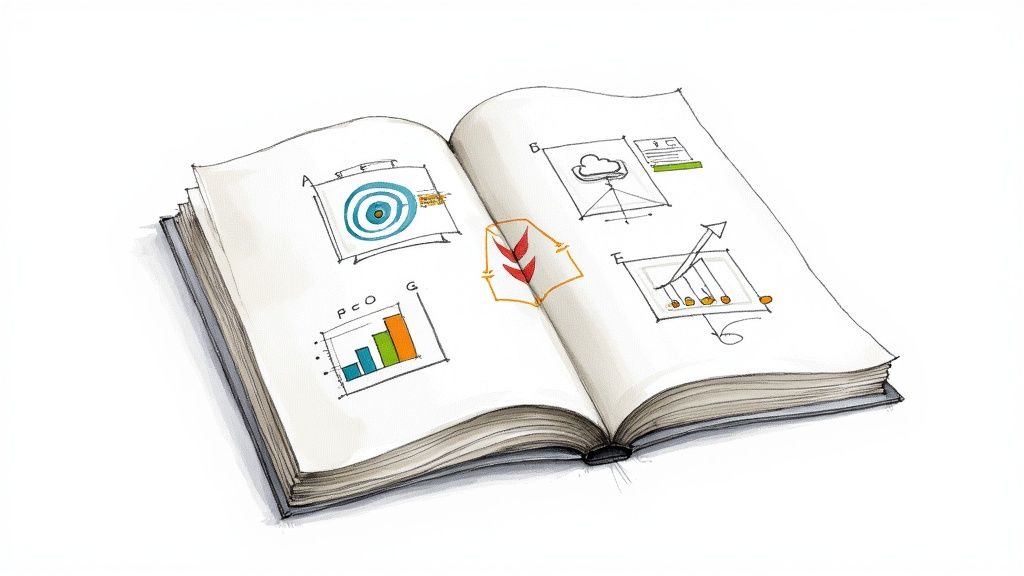
Let’s cut right to it: B2B SaaS marketing isn't about hawking software. It's about forging long-term, trust-based partnerships. Your goal isn't a one-time transaction; it's to consistently prove your product's value in solving real, complex business problems.
What B2B SaaS Marketing Really Means
Selling sophisticated software to a business is worlds away from selling a pair of sneakers to a consumer. Think of yourself as an architect designing a specialized foundation for a massive skyscraper. Your work demands absolute precision, a deep understanding of your client's needs for decades to come, and a plan that guarantees stability. That’s the core of B2B SaaS marketing.
This approach is all about building lasting relationships, not chasing quick wins or impulse buys. Every single marketing move you make is designed to build trust and demonstrate undeniable business value over the long haul. And the stakes are high. The global B2B SaaS market is on track to hit around $300 billion by 2025, with the average enterprise juggling about 275 different SaaS tools. With that much competition for attention, keeping your customers is everything—even a 5% drop in churn can spike profits by up to 95%.
The Three Pillars of B2B SaaS
At its heart, the B2B SaaS marketing field is shaped by three distinct challenges that make it unlike any other kind of marketing. These pillars dictate every strategy you'll ever use.
This infographic breaks down the foundational concepts that separate B2B SaaS marketing from everything else.
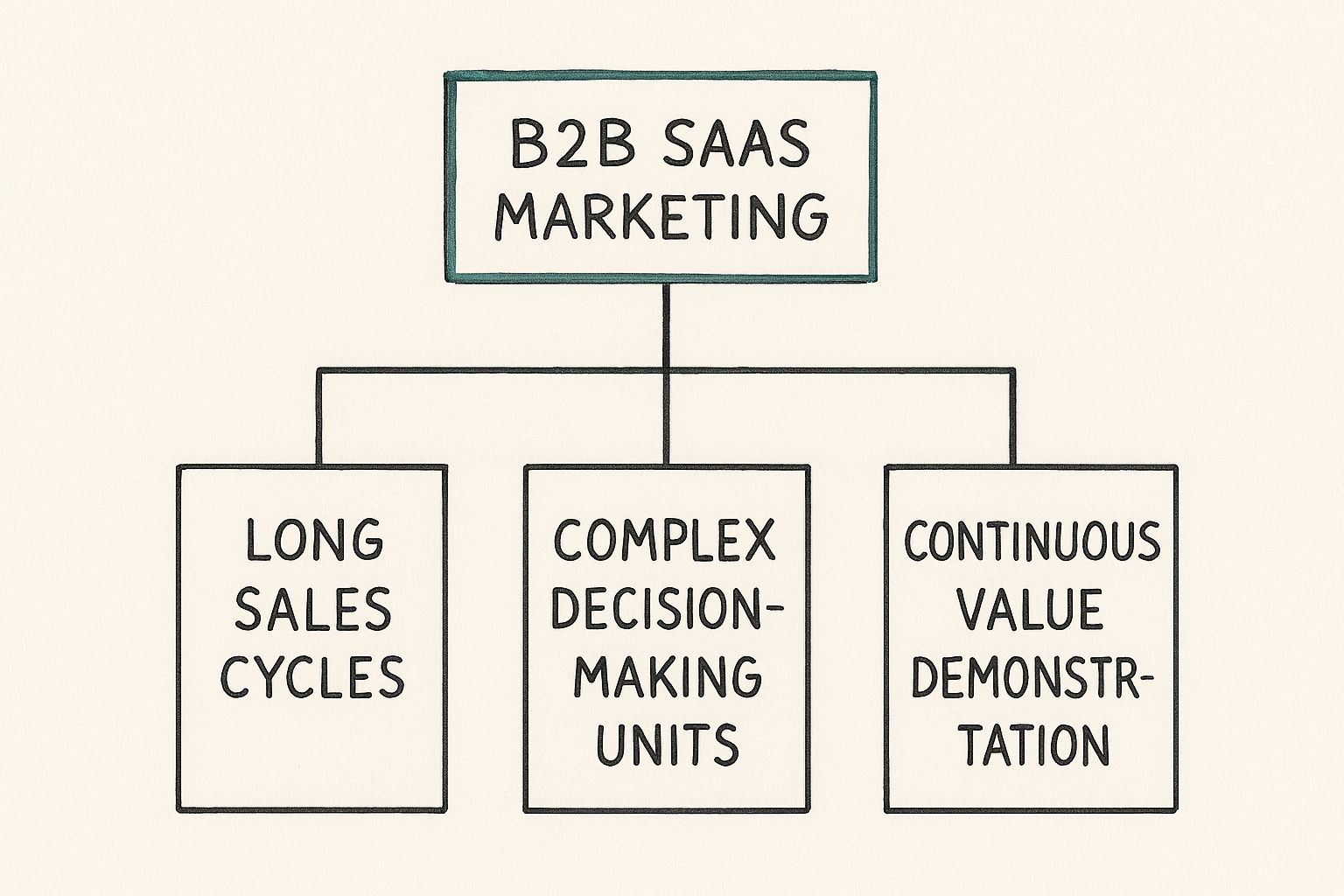
As the diagram shows, it all comes down to the long sales cycles, the complex web of decision-makers, and the relentless need to prove your value month after month.
- Long Sales Cycles: Big decisions don't happen overnight. We're talking months of demos, trials, and meeting after meeting before a deal is signed.
- Complex Decision-Making Units: You’re never selling to just one person. You have to win over an entire team—often including a CFO, a CTO, and the actual end-users—who all have their own priorities and pain points. That means you need a multi-faceted approach and have to know how to explain your product in a way that resonates with everyone.
- Continuous Value Demonstration: Getting the signature is just the starting line. Because SaaS is a subscription, you’re on the hook to constantly prove your worth to keep customers from churning and, ideally, encourage them to expand their usage.
Success in this field boils down to one simple mindset: your marketing must educate, build consensus, and prove tangible business outcomes. It’s a marathon of trust-building, not a sprint to a single sale.
To really get a handle on B2B SaaS, it’s a good idea to start by understanding digital marketing basics. That context will give you the foundation for the more specialized strategies we’re about to dive into. Let's get started.
Carving Out Your Market Position
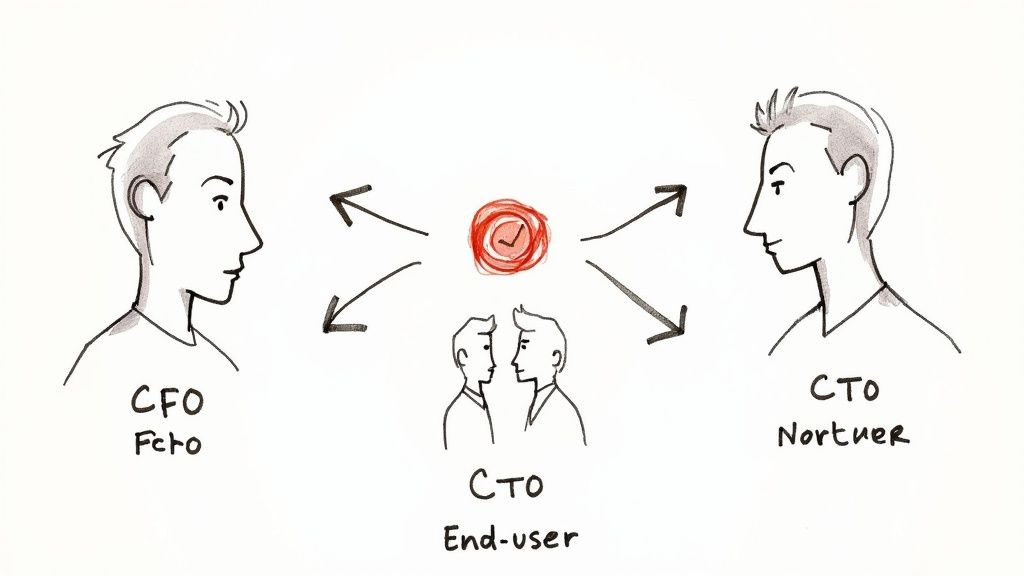
Before you spend a single dollar on ads, the most important battle in B2B SaaS is fought and won inside your customer's head. This is the battle for positioning. Forget catchy slogans—real positioning is the art of owning a specific, valuable piece of mental real estate.
It’s about becoming the only logical answer to a very specific, very painful business problem.
Think of it this way: a general-purpose hammer is useful, but an aircraft engineer can't live without their specialized rivet gun. Your product needs to be that rivet gun. It’s not for everyone, and that’s precisely its greatest strength. Powerful positioning is born from radical focus. It means intentionally choosing who you are not for, so you can become absolutely essential to the right audience.
Define Your Ideal Customer Profile With Precision
To get that kind of focus, you have to go miles beyond simple demographics. Your Ideal Customer Profile (ICP) isn't just a company size or industry vertical. It's a living, breathing blueprint of the organization that gets the most from your solution and, in turn, gives you the most value.
This means digging deep into the "why" behind their pain. Don't just identify their industry; understand the gnawing regulatory pressures they face. Don't just note their employee count; uncover the exact communication breakdowns that happen at that specific scale.
Your ICP should answer questions like:
- What specific workflow inefficiency is keeping their managers up at night?
- What technical debt in their current software stack is creating daily frustration?
- Which business goals are they completely unable to hit with their existing tools?
Answering these questions transforms your marketing from a generic broadcast into a highly targeted, resonant conversation. For a deeper look into the frameworks that help you achieve this focus, check out our guide on strategic B2B SaaS positioning.
Translate Features Into Business Outcomes
Once you know exactly who you're talking to, you have to speak their language. Here’s the truth: business decision-makers don't buy software features. They invest in business outcomes. Your messaging has to be the translator, converting every technical specification into a tangible result that matters to each person in the buying committee.
A feature like an "AI-powered analytics dashboard" is meaningless on its own. It's your job to translate it for different roles.
- For the CFO: This isn't an analytics dashboard. It's a tool that provides the "financial forecasting accuracy you need to reduce budget variance by 15%."
- For the CTO: This isn't just AI. It's a "secure, API-first platform that seamlessly integrates with your existing data warehouse, cutting down on engineering overhead."
- For the End-User: This isn't a dashboard at all. It's the ability to "generate a comprehensive weekly report in five minutes instead of five hours."
This translation is the heart of effective value articulation. It shifts the entire conversation from "what our product does" to "what your business will achieve." This is how you stop being a vendor and start becoming a strategic partner.
This entire process—defining your audience and articulating value—can be visualized through positioning maps. To get a handle on establishing your unique identity in the market, this comprehensive guide to brand positioning mapping is an excellent resource.
By clearly mapping where you stand, you make it easy for your ideal customers to find their way directly to you. This clarity is the bedrock of all successful B2B SaaS marketing.
Selecting Your Channels for Maximum Impact
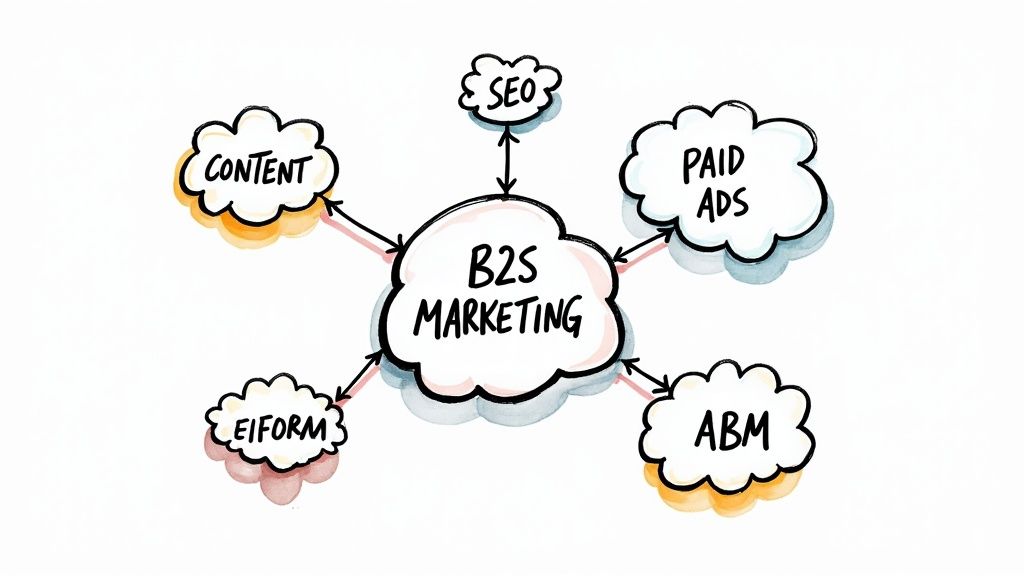
In B2B SaaS marketing, trying to be everywhere at once is the fastest way to get nowhere. A scattered, "spray and pray" approach just burns through your budget, exhausts your team, and fails to make a real dent with anyone.
The real magic happens when you get selective. It’s about mastering a few high-impact channels that line up perfectly with where your ideal customers actually spend their time and look for solutions.
This isn’t about chasing the latest shiny object. It’s about building an integrated system where every channel has a job to do, guiding prospects from their first flicker of awareness all the way to becoming vocal advocates for your brand.
The Pillars of a Strong B2B Channel Strategy
A winning b2b saas marketing plan is built on a foundation of carefully chosen channels. For most, this means a smart blend of long-term asset building and targeted, shorter-term acquisition tactics. You need a system that both pulls in potential customers and lets you go after high-value accounts with precision.
Let's break down the core pillars that form the bedrock of a successful strategy.
- Content Marketing as the Engine of Trust: This is your long game. Creating genuinely valuable content establishes you as an authority and educates your audience, building the deep trust required before a company makes a significant investment.
- Strategic SEO for Capturing Intent: SEO is how you make sure that when your ideal customers are actively hunting for a solution, your name is the first one they see.
- Paid Acquisition for Precision Targeting: Channels like LinkedIn and Google Ads let you get your message in front of specific decision-makers with surgical accuracy, giving your pipeline an immediate boost.
- Account-Based Marketing (ABM) for High-Value Targets: ABM flips the traditional funnel on its head, concentrating all your firepower on a handpicked list of dream accounts.
For a deeper dive into building out this system, our guide on choosing the right channels for B2B growth offers a fantastic framework.
Content and SEO: The Inbound Power Duo
Content marketing in the B2B SaaS world isn’t about just churning out blog posts. It’s about creating indispensable resources that solve real, complex problems for your audience. Think original research reports, technically dense whitepapers, or interactive ROI calculators that deliver immediate value.
This kind of content does more than just attract eyeballs; it cements your company’s position as an industry leader.
SEO is the delivery mechanism for all this valuable content. It’s what connects your expertise to the right people at the exact moment they need it. The focus here is on high-intent keywords—phrases that signal a prospect isn't just browsing, but is actively looking to buy. We're talking long-tail keywords like "enterprise project management software integration" rather than broad, generic terms like "project management."
By aligning problem-solving content with high-intent keywords, you create a powerful inbound magnet. You stop chasing customers and instead build a system where your ideal buyers find you.
Paid Acquisition: The Growth Accelerator
While content and SEO build long-term momentum, paid acquisition delivers immediate, predictable results. It’s the fastest way to get your solution in front of the exact people who can buy it. In B2B SaaS, two platforms reign supreme, each serving a distinct purpose.
Managing these channels well is critical. The average Customer Acquisition Cost (CAC) for B2B SaaS companies hovers around $205. To make paid channels profitable, you have to live in the data, constantly optimizing campaigns by blending creative messaging with scientific analysis.
Account-Based Marketing: The Focused Offensive
Finally, there’s Account-Based Marketing (ABM)—the pinnacle of focused B2B SaaS marketing. Instead of casting a wide net and hoping for the best, ABM identifies a small number of high-value target accounts and treats each one as its own market.
This hyper-personalized approach requires tight coordination between sales and marketing to deliver a seamless, compelling experience.
An ABM play might involve running targeted LinkedIn ads to key stakeholders at a specific company, followed by personalized email outreach from a sales rep referencing the very same content from the ad. It’s this kind of integrated, focused strategy that provides the most direct path to landing your most valuable, game-changing accounts.
Building Your Demand Generation Engine

If marketing channels are the roads that lead to your business, then your demand generation engine is the power plant that keeps the entire city running. This isn't about running a few scattered campaigns and hoping for the best. It’s about building a deliberate, repeatable system designed to consistently attract, engage, and qualify potential customers for your sales team.
Think of it as an assembly line for creating opportunity. At one end, you feed in raw interest from your target audience. At the other, you get sales-ready leads who not only understand their problem but are already leaning toward your solution as the answer. Every piece of this machine has to be built with intention and connected seamlessly to the next.
Crafting the Irresistible Lead Magnet
The whole process kicks off with a single, powerful value exchange. You need to offer something so genuinely useful that a prospect is more than willing to trade their contact information for it. This is your lead magnet, and in b2b saas marketing, a simple checklist just won’t cut it.
Your lead magnet is the very first tangible proof of your expertise. It must solve a real, specific pain point for your Ideal Customer Profile, delivering an "aha!" moment that immediately positions your company as a trusted guide.
Some of the most compelling B2B lead magnets include:
- Exclusive Industry Reports: Offer up original data and insights your audience can't just Google.
- In-Depth Technical Whitepapers: Provide a deep dive into a complex problem that your software is uniquely positioned to solve.
- Interactive ROI Calculators: Let prospects plug in their own numbers and see the potential financial impact of your solution for themselves.
- On-Demand Webinars: Host a masterclass on a critical topic, showcasing your team's authority and expertise.
This initial transaction is the front door to your entire demand-gen engine. It’s your chance to make a stellar first impression and earn the right to keep the conversation going.
Designing High-Conversion Landing Pages
Your lead magnet is the prize, but the landing page is the stage where the magic happens. A great landing page has one job and one job only: to convince the visitor to download your asset. Everything about it must scream clarity, focus, and persuasion.
There is absolutely no room for distraction here. Strip out the main navigation, kill any competing calls-to-action, and focus every single element—from the headline to the button color—on that one desired action. The headline must grab them by the collar by speaking directly to their biggest pain or most ambitious goal. The copy should then clearly articulate the value of what they're getting, explaining exactly what they will learn and how it will make their life better.
A great landing page isn’t just a form on a page. It’s the critical moment where a curious visitor becomes a known lead, officially entering your world and signaling their interest in what you have to say.
Automating the Nurture Sequence
Once someone downloads your lead magnet, the real work begins. You don't just hand the contact info over to sales. This is where you build a relationship through an automated nurture sequence. This carefully crafted series of emails is designed to guide your new lead from initial awareness toward a genuine consideration of your product.
Each email should build on the last, delivering more value and gently moving the prospect down the path. It’s a delicate dance.
- Immediate Delivery: The first email gets them what they asked for right away and says a simple thank you.
- Follow-up Value: A few days later, send a related piece of content—maybe a blog post or a short video that expands on the original topic. Keep giving.
- Introduce the Problem: Now, you start to frame the larger problem that your software solves, using insights from the lead magnet to make it hit close to home.
- Introduce the Solution: Finally, you can introduce your product as the logical solution, directly connecting its features to the challenges you've been discussing.
This automated flow ensures every single lead gets a consistent, valuable experience that educates them and builds trust over time. It’s how you turn a cold contact into a warm, informed prospect. This process is a core component of the top B2B demand generation strategies that the most successful companies rely on to keep their pipelines full. By building this engine, you create a system that reliably turns interest into revenue.
Measuring Success and Proving ROI
In B2B SaaS, a brilliant marketing idea is only as good as the numbers it produces. Let's be honest: your creativity needs to be backed up by cold, hard data. We're not just building brand awareness here; our job is to directly fuel the company's growth engine. If you want a real seat at the leadership table—and the budget that comes with it—you have to speak the language of the boardroom. That language is Return on Investment (ROI).
This means looking past the easy "vanity metrics" like social media likes or even raw website traffic. Sure, they can be useful signals, but they don't tell the whole story. The real work is drawing a clear, undeniable line from your marketing campaigns straight to the company's bottom line.
Moving Beyond Vanity Metrics
The modern B2B SaaS marketing team isn't a cost center; it's a revenue engine. To prove that, we have to obsess over the metrics that actually matter to the financial health of the business. These are the numbers that your CEO and CFO lose sleep over because they signal sustainable, predictable growth.
And this shift is more critical than ever. By 2025, it's projected that about 85% of all business software will be SaaS-based, pushing the market toward a staggering $400 billion. In an arena this crowded, proving your financial contribution isn't just a good idea—it's the only way to survive and thrive. You can discover more insights about SaaS market growth on digitalsilk.com.
To prove your worth, you have to master a handful of Key Performance Indicators (KPIs) that connect what you do every day to customer acquisition, retention, and—most importantly—revenue.
The KPIs That Define B2B SaaS Success
Think of these metrics as the vital signs of your marketing's health. They don't just tell you what happened; they help you understand why it happened and what's likely to happen next. Tracking them lets you make smarter decisions, optimize your spend, and forecast future growth with confidence.
These aren't just numbers on a spreadsheet; they are the core of a data-driven marketing strategy. Every B2B SaaS marketer should know them by heart and be able to speak fluently about their performance.
Essential B2B SaaS Marketing Metrics
Mastering these KPIs changes the entire conversation you have with leadership.
Instead of saying, "Our last campaign brought in 500 leads," you can confidently state, "Our last campaign generated a pipeline worth $250,000 with a projected LTV-to-CAC ratio of 4:1."
See the difference? One is a marketing activity. The other is a business outcome.
Building a Dashboard That Tells a Story
Just collecting this data isn't enough. You have to present it in a way that's clear, concise, and tells a compelling story. This is where a well-designed analytics dashboard comes in. It should be a visual narrative of your performance, connecting the dots between your team's activities and the company's financial results.
For a deeper dive into the specific metrics to track and how to build dashboards that truly drive growth, you should check out our guide on B2B marketing analytics.
Ultimately, your goal is to build a predictable system. A system where you know that for every dollar you put into marketing, you can expect a specific, measurable return. That’s how you transform your team from a support function into an indispensable, revenue-generating powerhouse.
Got Questions? We’ve Got Answers.
Navigating B2B SaaS marketing can feel like you’re trying to assemble furniture with instructions written in a different language. As you start putting the pieces of your strategy together, some questions are bound to pop up again and again.
This section tackles the most common hurdles and strategic forks in the road that founders and marketers face. Think of it as your go-to reference when you hit a wall, offering straight answers to guide your next move.
What Is the Biggest Hurdle in B2B SaaS Marketing?
Hands down, the biggest challenge is the long, incredibly complex sales process. This isn’t like selling a pair of sneakers; you’re selling an organizational change initiative. And a B2B purchase decision is almost never made by one person.
Instead, you’re dealing with a buying committee. Picture a roundtable with stakeholders from finance, IT, operations, and the actual end-users—each with their own agenda. The CFO is laser-focused on ROI, the CTO is grilling you on security and integration, and the team lead just wants to know if it will make their daily life easier. Your marketing has to speak to all of them, all at once.
This completely changes the game. Marketing becomes less about quick persuasion and more about a patient, long-term educational effort. Your job is to build trust and deliver undeniable value at every single touchpoint, often over several months. The real hurdle is keeping that momentum and relevance alive across an entire organization, guiding them all toward a confident “yes.”
How Does Content Marketing Differ for B2B SaaS?
Content for B2B SaaS has to be fundamentally utilitarian. While B2C content can focus on emotion, lifestyle, and entertainment, your content’s primary job is to solve sophisticated business problems with credible, expert-level information.
Your audience isn’t scrolling for a distraction. They are actively hunting for solutions that will impact their company's bottom line, boost efficiency, or head off a major risk. This demands a totally different caliber of content.
Forget short, catchy blog posts. The gold standard in B2B SaaS marketing includes things like:
- In-depth technical whitepapers that meticulously break down a complex industry challenge.
- ROI-focused case studies that offer hard numbers and tangible proof of your product’s value.
- Original research reports that present unique data and position your company as a thought leader.
- Expert-led webinars that teach a specific skill or methodology, proving your authority in the space.
The goal isn't just to attract an audience; it's to arm your internal champion with the proof they need to build a compelling business case on your behalf. Every piece of content you create is another tool for their arsenal.
Should a B2B SaaS Startup Prioritize Inbound or Outbound?
For the vast majority of B2B SaaS startups, building a robust inbound marketing strategy is the most sustainable and scalable path to long-term growth. An inbound approach, built on the twin pillars of smart SEO and high-value content, creates a powerful, compounding asset for your business.
Think of it like building a lighthouse. It takes a ton of upfront work to construct, but once it’s lit, it works tirelessly to guide ships (your ideal customers) to your shore. It attracts prospects who already know they have a problem and are actively looking for a solution—which means more qualified and motivated leads for you. Over time, your cost to acquire each new lead actually goes down as your content library and search authority grow.
Outbound marketing, like cold email campaigns or targeted ads, can definitely get you faster results in the short term. It’s great for testing your messaging or going after a specific list of high-value accounts. But it requires constant fuel—your budget. The second you turn off the ad spend, the leads dry up.
The most effective strategy is usually a hybrid one. Start by laying a strong inbound foundation to ensure you have a long-term, organic growth engine. Then, strategically layer in targeted outbound or Account-Based Marketing (ABM) campaigns to go after your dream enterprise accounts with surgical precision. This approach gives you both sustainability and the power to hit the accelerator when you need to.
At Big Moves Marketing, we specialize in transforming complex product features into compelling market positions. If you're ready to build a launch strategy that drives adoption and secures revenue for your B2B SaaS or AI startup, let's connect. Learn more about how we can help you win deals at https://www.bigmoves.marketing.
%20-%20Alternate.svg)
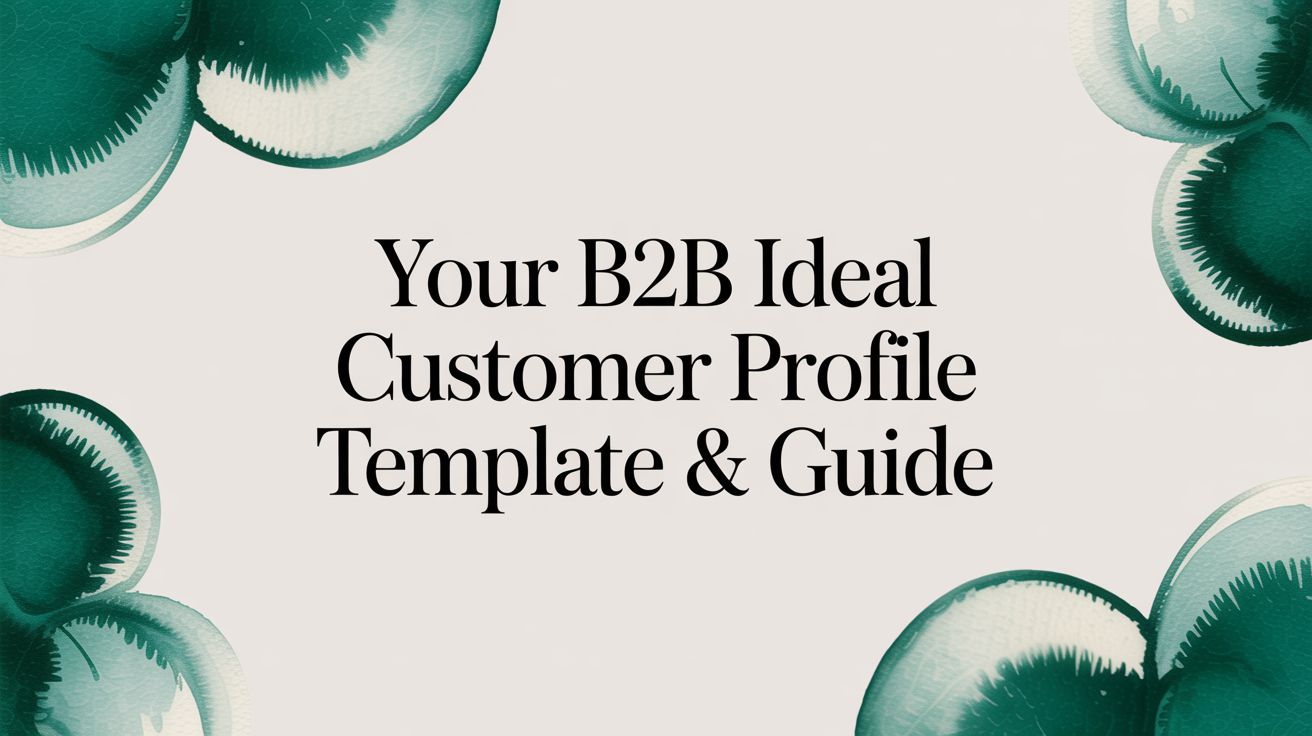

%20-%20white.svg)